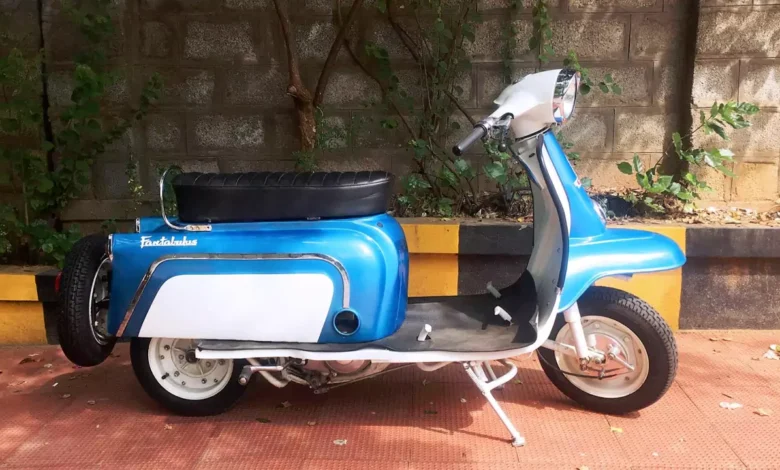The Royal Enfield Fantabulus: A Forgotten Icon of the Indian Scooter Revolution

When it comes to motorcycles and scooters, Royal Enfield is most recognised for its durable and classic models, such as the Bullet, Himalayan, and Classic series. But early in the 1960s, Royal Enfield also made a foray into the scooter market with the Royal Enfield Fantabulus, a model as distinctive as its moniker. The Fantabulus was a daring attempt by the company to capitalise on the rising demand for scooters in India, even though it may not be a household name now.
Let’s examine in detail this frequently disregarded scooter’s design, history, and legacy.
The Situation: India’s Expanding Scooter Industry
India’s car industry was still in its infancy in the 1950s and 60s. The majority of automobiles on the road were either imported or built within the nation under licence from overseas producers. Scooters gained popularity as a cost-effective and dependable mode of transportation for middle-class families and individuals seeking efficient personal transit as cities expanded.
Scooters such as the Vespa and Lambretta entered the Indian market during this period. These scooters were an appealing choice for many individuals since they were lightweight, simple to operate, and reasonably priced. After observing the popularity of these models, Royal Enfield made the decision to introduce a unique scooter to the market. Thus, 1962 saw the birth of the Fantabulus.
The Fantabulus’s Inception
In contrast to several lightweight scooters from that era, the Royal Enfield Fantabulus was intended to be a strong and function-focused vehicle. It was intended for anyone who desired a little bit more power and style in their vehicle, not just commuters.
The Fantabulus’s engine was its most notable feature. It was fitted with a Villiers single-cylinder, two-stroke, 175cc engine, which was a big improvement over the 125cc and 150cc engines that were standard on scooters at the time. Its superior acceleration and top speed over rival scooters were attributed to the engine’s marriage to a four-speed gearbox, an uncommon feature for scooters at the time.
The Fantabulus demonstrated Royal Enfield’s reputation for producing reliable motorbikes. In keeping with the company’s performance and durability ethos, the frame was robust and the entire build quality was outstanding. Being among the first scooters with electric start increased convenience and luxury, particularly since starting two-stroke motors may be difficult.
Design: Blending Traditional and Modern Styles
The design of the Royal Enfield Fantabulus distinguished it from the more conventional-looking scooters of the day. The majority of scooters adhered to the traditional rounded, curved appearance, but the Fantabulus went more towards an angular, futuristic look. Its front end was very distinctive, almost like a motorbike, with the headlamp built into the body instead of mounted on the handlebar.
With a pointed rear fender and an expanded seat that offered plenty of room for both the rider and a pillion, the scooter’s bodywork had a sleek appearance. The scooter had a commanding presence on the road because to its huge, wide handlebar. Royal Enfield also considered functional elements, such as storage. For riders carrying little objects, the Fantabulus’s storage box located in front, beneath the leg shield, was a helpful feature.
The petrol tank of the Fantabulus was positioned beneath the seat rather than in the front, which was one of its more unusual features. By reducing the centre of gravity, this design modification enhanced handling and stability, particularly at faster speeds.
Performance: A Powerful Scooter
The Fantabulus’s look was striking, but its performance was what really made it stand out. The scooter had a 175cc Villiers engine that produced about 8 horsepower, which isn’t much by modern standards but was quite a lot at the time. Because other scooters from that era prioritised simplicity and fuel economy over power, the Fantabulus stood out in terms of performance.
An further factor in the ride’s versatility and smoothness was the four-speed gearbox. When necessary, riders could alter gears to maximise torque and acceleration, which allowed the Fantabulus to manage both broad roads and city traffic with remarkable ease. It was faster than the majority of scooters at the time, reaching a top speed of about 60 km/h.
The Fantabulus was renowned for its ride quality in addition to its power. With coil springs at the back and telescopic forks up front, the suspension was built to withstand the harsh roads of India. This made the trip comfortable even on rough terrain. Another element that enhanced the scooter’s usability and appeal was the electric start, which made starting up quicker and easier than using a kickstart.
Difficulties: Why Did It Fail?
The Royal Enfield Fantabulus could not achieve commercial success, even with its exceptional performance and abundance of unique features. A number of variables had a part in its short lifespan and ultimate termination.
The cost was one of the main causes. Because of its higher price tag and luxury positioning, the Fantabulus was out of the reach of many purchasers who were searching for a dependable, reasonably priced scooter. Rivals such as Vespa and Lambretta provided models that were not only more affordable but also more well-established in the industry, with a solid track record of dependability and readily available replacement parts.
The scooter’s intricacy was another factor. Although the electric start and four-speed gearbox were novel innovations, they also increased the Fantabulus’s complexity and maintenance costs. These characteristics would have been viewed more as a burden than an asset by a market that valued simplicity and minimal operating expenses.
The Fantabulus’s Legacy
Despite its lack of commercial success, the Royal Enfield Fantabulus is nevertheless a significant period in the company’s history. It was an audacious attempt to push the limits of engineering and design in order to produce a performance-focused scooter. Additionally, the Fantabulus serves as a reminder of Royal Enfield’s propensity for innovation and experimentation, even in fields unrelated to its primary motorbike industry.
Just a few Fantabulus models remain in existence today, making it a rare collector’s item. Owning a Fantabulus, a scooter that dared to be unique at an era when conformity controlled the roads, is like owning a piece of Indian automotive history for enthusiasts and collectors.
In summary
Despite its brief existence, the Royal Enfield Fantabulus had a lasting impact on the Indian scooter scene. It stood out in a crowded market thanks to its cutting-edge features, strong engine, and creative design. Even if its more accessible and straightforward rivals eventually eclipsed it, Royal Enfield’s Fantabulus nonetheless stands as a testament to its engineering prowess and ambition.
